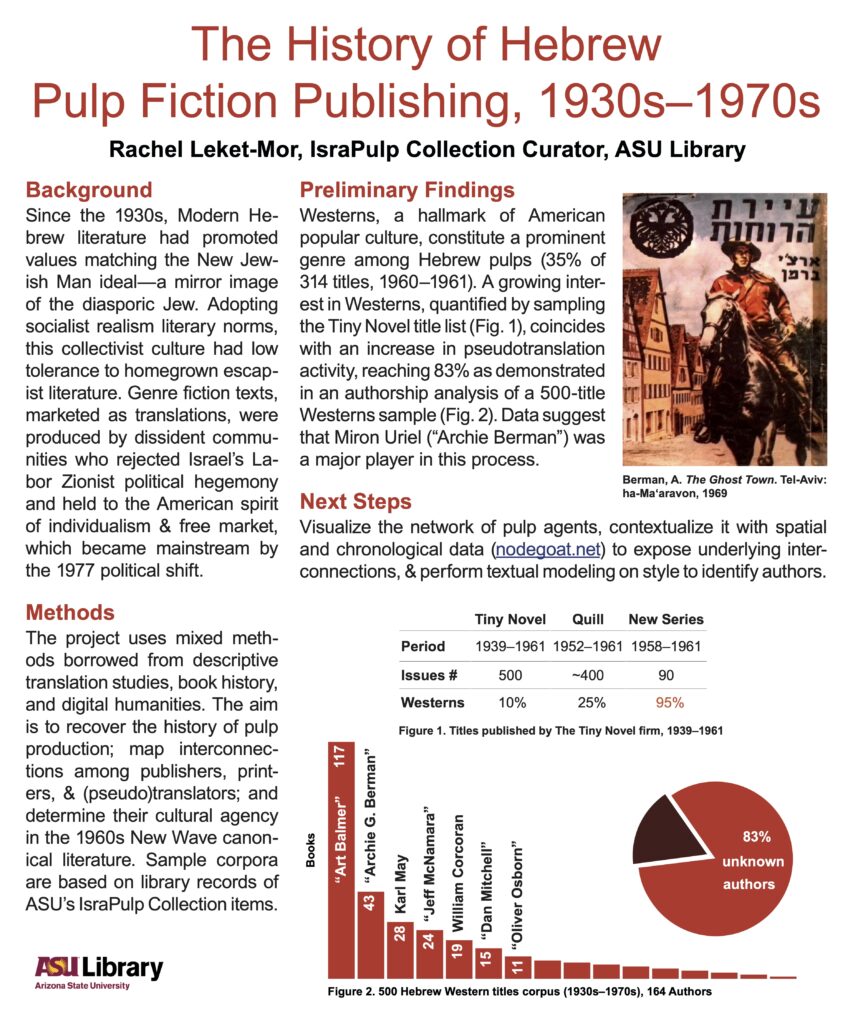Blog post by Rachel Leket-Mor, ASU Library
The existence of Hebrew pulp literature may be surprising to many in view of the history of this ancient language, typically associated with biblical and other sacred Jewish writings. Yet mystery, adventure, and romance fiction written in Modern Hebrew, as well as an avid readership, were thriving for some fifty years from the early 1930s until the end of the 1970s. This body of literature embodied trivial, formulaic, possibly smutty textual production, as did other twentieth century pulps—with a few significant distinctions.
Unlike most modern languages, Hebrew was dormant for many centuries—especially as a spoken language—before it was revived in mid-nineteenth century Eastern Europe. Its millennia-long legacy as a vehicle for predominantly religious purposes (although poetry, philosophy, and scientific texts were also written in Hebrew) obliged its contemporary speakers to use it with care. Writers were held dear in this revivalist community of Hebrew speakers, which was closely related in its values and ideals to both the Zionist movement and collectivist Socialism. Regarded as a sort of secular prophets, Hebrew writers in Eastern Europe and later in Palestine (1880–1948) were expected to lead the national Jewish revival with appropriate poetry and fiction works. This elitist literature, which contained many translated texts, and original works based on their literary models (mainly from Russian or German), was later sponsored by established Labor Zionist publishing houses supported by the political system of the Jewish community in Palestine. Original escapist fiction in Hebrew was unacceptable in this ideal-driven culture.
It was due to these circumstances that popular literature in Hebrew was predominantly written and distributed on the political fringe, mostly by right-wing dissidents (Ben-Ari 2012). Moreover, since the mainstream, official culture had no room for original popular fiction, many of the pulpy texts were masqueraded as translations from American English; that is, their colorful, sensational covers featured Americanized author names although they were in fact originally written in Hebrew. To hide their source, the pseudotranslated texts also emulated the phraseology, syntax, and vocabulary of translated texts. The publishers of these books hid under ephemeral names and left no business or personal papers in archives.
The cultural significance of Hebrew pulp literature has not been broadly studied yet due, in part, to the scarcity of source materials in libraries. The IsraPulp Collection at ASU Library, created to remediate this situation, is a research collection focused on this marginalized literature and other politically subversive print materials (Leket-Mor 2011). The collection includes thousands of rare items representing all pulp genres and a few primary sources, all housed at ASU’s Distinctive Collections.
Set to recover the history of Hebrew pulp fiction publishing, the current project is based on a sample of Westerns, one of the most popular genres in this corpus. My research mixes analyses of print techniques and cover art representations, linguistic and translation studies methods, and computational analysis of library records. Digital humanities methods I plan to employ once more texts become available digitally include textual modeling of the corpus, in order to identify specific author styles and follow their contribution to this publishing history; and contextualize the network of pulp agents, including authors, translators, illustrators, and publishers, with spatial and chronological data.

Additional Resources
Almog, Oz. 2000. The Sabra: The Creation of the New Jew. Berkeley: University of California Press.
Ben-Ari, Nitsa. 2006. Suppression of the Erotic in Modern Hebrew Literature. Ottawa: University of Ottawa Press.
Ben-Ari, Nitsa. 2012. “Political Dissidents as Translators, Editors, and Publishers.” Translation and Interpreting Studies: The Journal of the American Translation and Interpreting Studies Association 7 (2): 144–160. https://doi.org/10.1075/tis.7.2.03ben.
Leket-Mor, Rachel. 2011. “IsraPulp: The Israeli Popular Literature Collection at Arizona State University.” Judaica Librarianship 16: 1–53. https://doi.org/10.14263/2330-2976.1003.
Leket-Mor, Rachel. Forthcoming. “My Heart Is in the West and I Myself Am on the Eastern Edge: Hebrew Pulp Westerns and the Sabra Cowboy.” In The Literary Western in the Global Imagination, edited by David Rio, Marek Paryz, and Christopher Conway. Leiden: Brill.
Raab, Alon, and Eli Eshed. 2012. “With a Star of David He Swings: Tarzan in the Holy Land,” in Global Perspectives on Tarzan: From King of the Jungle to International Icon, edited by Annette Wannamaker and Michelle Ann Abate, 123–148. New York: Routledge.
Toury, Gideon. 1995. Descriptive Translation Studies and Beyond. Amsterdam: John Benjamins Publishing.
